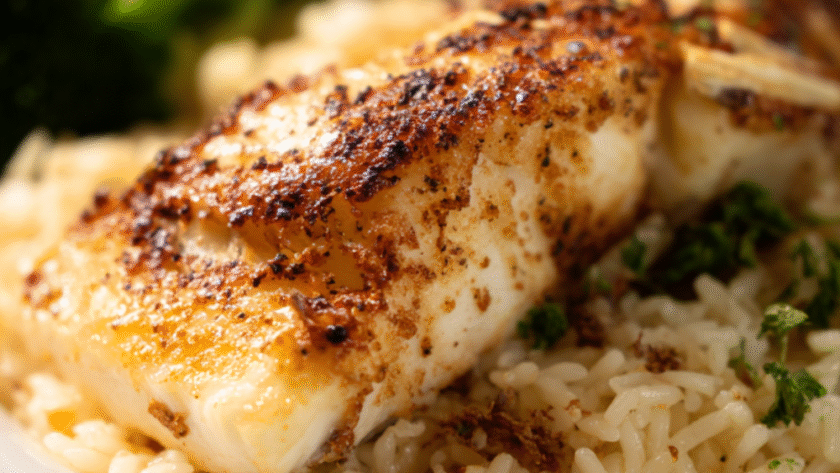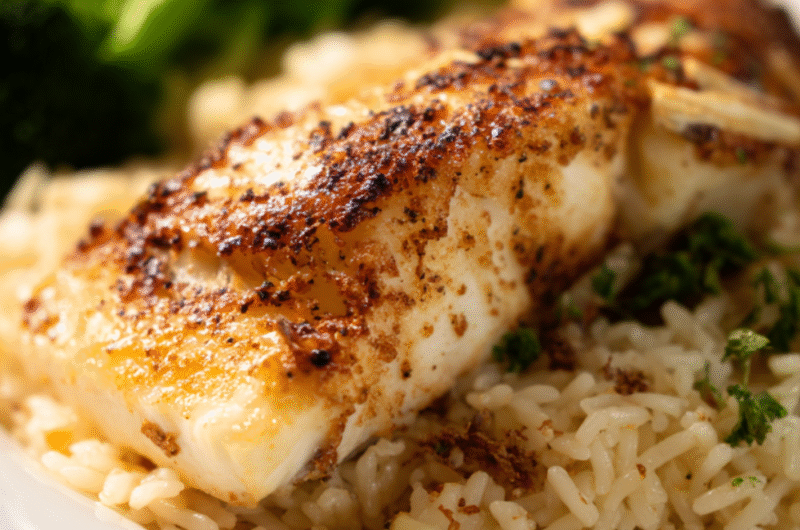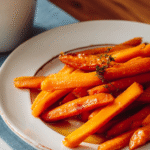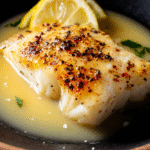This Gordon Ramsay’s Pan-Seared Halibut Recipe is a crispy and golden recipe, which is made with flaky halibut fillets and a rich lemon butter sauce. It’s the perfect 30-minute meal, ready in about 15 minutes.
Jump to RecipeGordon Ramsay’s Pan-Seared Halibut Recipe Ingredients
For the fish:
- 680g halibut fillets
- 1/2 tsp garlic powder
- 1/2 tsp paprika
- 1 tsp sea salt
- 1/4 tsp black pepper
- 2 tbsp olive oil
For the sauce:
- 115g salted butter
- 1 lemon, halved (zest optional but encouraged)
How To Make Gordon Ramsay’s Pan-Seared Halibut
- Prep the halibut: Pat the halibut fillets completely dry with paper towels. Season both sides generously with the garlic powder, paprika, sea salt, and black pepper.
- Sear the fish: Heat the olive oil in a large skillet over medium-high heat. Once the oil is hot and shimmering, carefully place the halibut fillets in the pan. Let them sear, untouched, for 3–4 minutes, until the bottom is golden brown and the edges are turning opaque.
- Flip and finish: Gently flip the fillets. Continue to cook for another 2–4 minutes, depending on the thickness, until the fish is cooked through and flakes easily with a fork. Transfer the cooked halibut to a plate and cover loosely with foil to keep warm.
- Make the brown butter sauce: Reduce the heat to medium-low. Add the butter to the same skillet. Let it melt and continue to cook, stirring or swirling the pan occasionally, for 2–3 minutes. It will foam up and then subside, leaving the butter a golden-brown color with a nutty aroma.
- Add the lemon and serve: Once the butter is browned, squeeze the juice from both lemon halves into the pan. Let it bubble and simmer for another minute to thicken slightly. To serve, spoon the lemon butter sauce onto plates, place the halibut fillets on top, and drizzle with any remaining sauce.
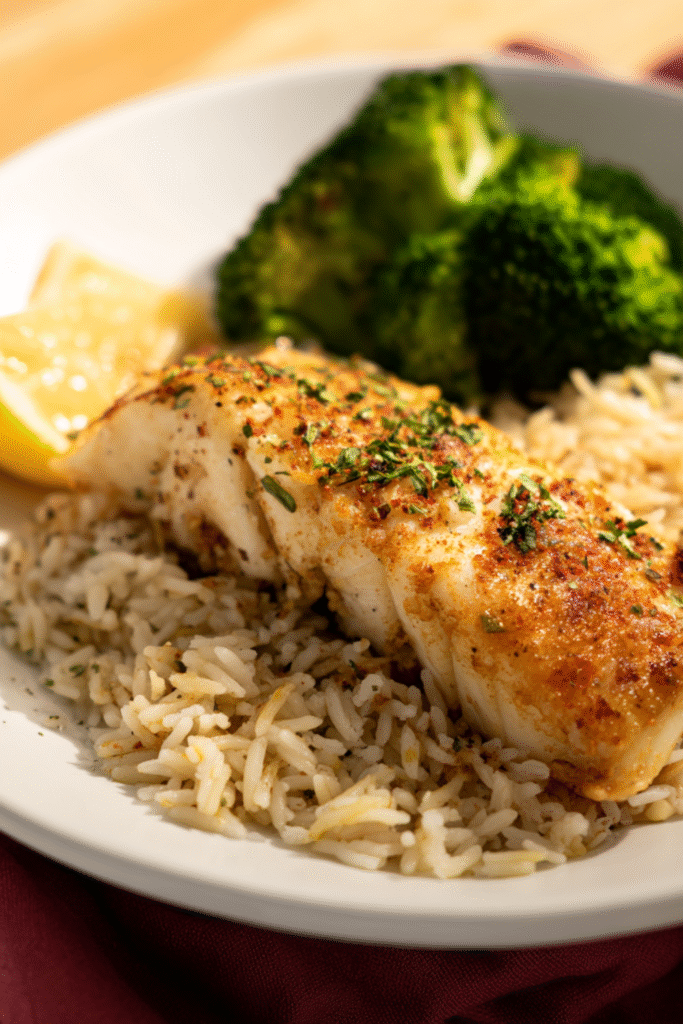
Recipe Tips
- How do I get a perfect, crispy sear? The two most important secrets are a very dry fish and a very hot pan. Patting the halibut completely dry with paper towels is essential. Also, make sure your oil is shimmering hot before you place the fish in the pan.
- How do I know when the halibut is done? Halibut is perfectly cooked when its color changes from translucent to opaque and it flakes easily when gently prodded with a fork. Be careful not to overcook it, as it can become dry.
- What is brown butter and why use it? Brown butter (or beurre noisette) is made by cooking butter until the milk solids toast and turn brown. This process gives the butter a deep, nutty, and incredibly rich flavor that is far more complex than simple melted butter.
- Why shouldn’t I move the fish while it’s searing? Leaving the fish untouched in the hot pan allows it to form a beautiful, golden-brown crust. If you move it around, it will steam rather than sear and is more likely to stick.
What To Serve With Pan-Seared Halibut
This elegant fish dish pairs well with a variety of simple sides that won’t overshadow its flavor:
- Roasted asparagus or green beans
- Creamy risotto or a simple rice pilaf
- Sautéed spinach with garlic
- A light arugula salad with a lemon vinaigrette
How To Store Pan-Seared Halibut
Refrigerate: Store leftover cooked halibut in an airtight container in the refrigerator for up to 2 days. Reheat: Reheat the fish gently in a skillet over low heat or in a 350°F (175°C) oven for a few minutes until just warmed through. Be careful not to overcook it.
Pan-Seared Halibut Nutrition Facts
- Calories: 300 kcal
- Carbohydrates: 3g
- Protein: 35g
- Fat: 16g
- Saturated Fat: 7g
- Sodium: 650mg
Nutrition information is estimated per serving and may vary based on ingredients and cooking methods used.
FAQs
My fish stuck to the pan. What went wrong?
Fish sticking is usually caused by one of two things: the pan wasn’t hot enough when the fish was added, or the fish wasn’t patted dry enough. A hot pan creates a barrier that prevents sticking.
Can I use a different type of fish?
Yes, this pan-searing method and brown butter sauce work beautifully with other firm white fish fillets like sea bass, cod, or mahi-mahi.
Can I make the sauce with regular melted butter?
You can, but you will miss out on the deep, nutty flavor that makes the brown butter sauce so special. Taking the extra 2-3 minutes to brown the butter is highly recommended and elevates the entire dish.
Try More Recipes:
- Gordon Ramsay’s Prime Rib Roast Beef Recipe
- Gordon Ramsay Beef Liver Recipe
- Gordon Ramsay Corned Beef And Cabbage Recipe
Gordon Ramsay’s Pan-Seared Halibut Recipe
Course: DinnerCuisine: British-InspiredDifficulty: Easy4
servings5
minutes10
minutes300
kcalA quick and elegant dish of pan-seared halibut with a crispy, golden crust and a rich, nutty lemon brown butter sauce.
Ingredients
680g halibut fillets
1/2 tsp garlic powder
1/2 tsp paprika
1 tsp sea salt
1/4 tsp black pepper
2 tbsp olive oil
115g salted butter
1 large lemon, halved
Directions
- Pat halibut fillets completely dry and season both sides with garlic powder, paprika, salt, and pepper.
- Heat olive oil in a skillet over medium-high heat until shimmering.
- Sear the halibut, untouched, for 3–4 minutes until the bottom is golden brown.
- Flip the fillets and cook for another 2–4 minutes until the fish is opaque and flaky. Remove from pan.
- In the same pan over low heat, melt the butter and cook until it turns a nutty, golden brown (2-3 mins).
- Squeeze the lemon juice into the brown butter and let it simmer for 1 minute.
- Spoon the sauce over the halibut to serve.
Notes
- Patting the fish bone-dry is the most crucial step for a crispy, non-stick sear.
- A hot pan is essential. Wait for the oil to shimmer before adding the fish.
- Watch the butter carefully as it browns to prevent it from burning.
- This recipe is also excellent with other firm white fish like cod or sea bass.
